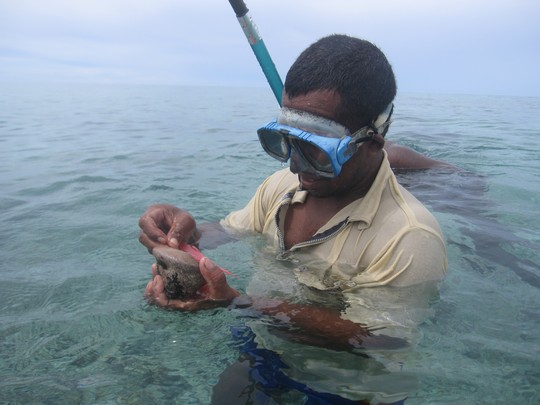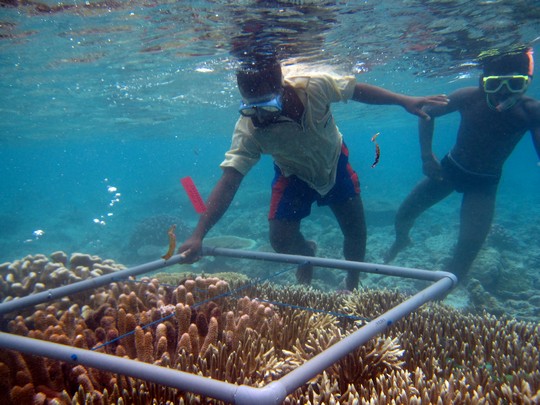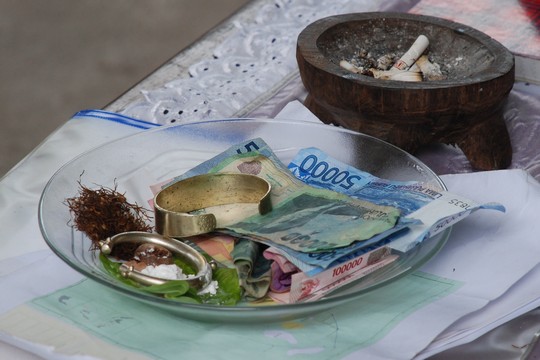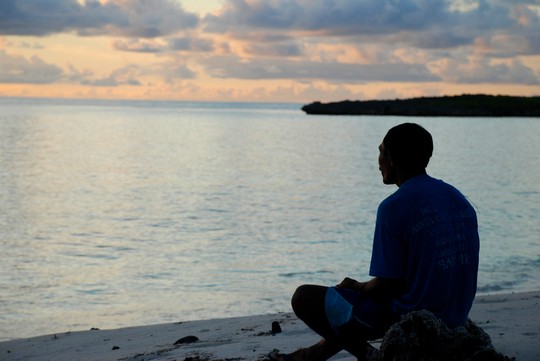Local culture is moulding conservation approaches on an eastern Indonesian island
Dirk J. Steenbergen
Dawn spills over the western coast of Kei Kecil, as an overladen taxi bus stammers onto the sleepy harbour pier of Debut. A single loud blast from the exhaust shatters the silence as the taxi bus comes to a sudden halt. Its bulging cargo spills over onto each side. Villagers returning home after their monthly agar-agar (seaweed) sales in Tual disembark at the pier, as a group of young men start to load the cargo onto a docked motorboat boasting the proud name of ‘Buah Kenangan’ (‘Memento’).
The small crowd is quick to follow as all board the vessel. Soon Buah Kenangan’s rhythmic engine fires into gear, pulling her away from the coast and leaving in her wake only the fading chatter of her passengers. The vessel is homebound for the small island of Tanimbar Kei located on the outer southwestern fringe of the Kei Archipelago, some five hours from Debut. A unique and proud island community with a rich heritage, Tanimbar Kei and its people form the centre of this village portrait.
It is often assumed that the prevailing currents of globalisation, whether these be social economic or political influences, will simply wash away the diversity of indigenous cultures and the remote environments of local communities. However, many such communities show the capacity and initiative to uphold local cultural norms and survive on their terms. Such resilience also leads us to question popular claims that when community-based development or conservation programs in remote locations fail, they do so as a consequence of a lack of will or capacity on the part of local people. Tanimbar Kei’s story shows that local people often have the will and the capacity to preserve their culture and environment, while improving their livelihoods at the same time.
A dramatic transition
A short hour flight to the southeast from Ambon lies the Kei Archipelago, making up the district of Southeast Maluku. The small island of Tanimbar Kei is located on the edge of the archipelago, in the subdistrict of Kei Kecil Barat, some five hours by boat from Kei’s economic centre, Tual. With a small village of about 600 people, Tanimbar Kei has become known locally for its strong traditional culture or adat.
 |
|
Measuring a trochus shell for resource monitoring purposes/Dirk Steenbergen |
The social core of the adat community still resides in the original village grounds perched high on a cliff overlooking an expanse of shallow mudflats, and is made up of three main kinship groups, or ‘laowan’. Adat in Tanimbar Kei is intimately interwoven with its ecological environment. Local people’s ancestral dependence on the environment has produced a very strong sense of local ownership of land and marine resources. The residents still manage these resources according to complex adat norms and beliefs.
As recent as 40 years ago, livelihoods on Tanimbar Kei revolved exclusively around barter trade of copra, sea cucumber and trochus shell (lola). Many elders recount long arduous journeys to cities as distant as Makassar, Surabaya, and Kupang to trade.
Since those days, Tanimbar Kei’s economy has undergone dramatic transition. With the arrival of motorised vessels in Kei and the growth of Tual as the archipelago’s economic centre, the local village economy has shifted. Gone are the long but rare trading journeys, replaced by more frequent trade with middlemen in Tual. Furthermore, since 2005 villagers have successfully ventured into the cultivation of agar-agar (seaweed), driven by high demand from industries in Java. Today Tanimbar Kei’s local economy is largely fuelled by the agar-agar and copra trade with brokers in Tual.
Recent decades have also seen the influx of settlers onto the island. The influx meant new enclaves formed on the island creating a diverse religious milieu. Currently, the village boasts Protestant and Catholic churches, and a mosque, aside from the adat community’s Hindu Temple (locals can only get government recognition of their adat if it is classified under the umbrella of one of Indonesia’s six official religions, so they have labelled themselves Hindus).
Managing the marine environment
As an island community, Tanimbar Kei’s dependence on marine resources is very high. It comes as no surprise, therefore, that management of such resources has evolved as an essential element in Tanimbar Kei society. Traditional management methods have sustained past generations and continue to do so, despite recent social and economic changes.
 |
|
Checking on coral coverage is one part of the conservation team’s activities /Dirk Steenbergen |
Seasonal adat closures of marine areas, known in the archipelago as ‘sasi’, or in Tanimbar Kei to as ‘hawear’, have long been practised by coastal communities. The aim is to allow the regeneration of harvestable marine resources like sea cucumber and trochus shell by not subjecting them to constant harvesting. For a specified period, marine areas are opened for harvesting of a certain species. Sasi openings can last anywhere between a few days and a few weeks, after which the areas are closed again for up to several years at a time depending on local supply and demand. The opening and closure of a sasi is accompanied by elaborate adat rituals and rules, which in turn are strictly controlled by an adat leader.
‘He can read the environment, and can communicate with the gods to determine when sasi can be opened so that we can collect lola [trochus shell]. We simply wait for his announcement... He determines how long sasi is open for, and also will know when someone violates the rules, even without being there. He will simply know’, a fisher told me.
Community members assiduously adhere to these adat rules, as heavy sanctions follow any malpractice. Past accounts mention that sanctions for adat violations could vary in severity from payments of gold taels (including coins and bracelets) or antique canons to public humiliation or even exile, according to the gravity of the violation. Nowadays sanctions that follow from fishing or sasi violations generally involve a combined payment of a monetary fine, gold bracelets, sirih-pinang (betel nuts) and/or tobacco.
In the past, the community profited from high seasonal yields during sasi openings. Over recent decades, these yields have declined. One reasons is the ongoing impact of destructive fishing by community members, which continued up to the 1990s, and continuing destructive fishing by outsiders. The intensive application of potassium cyanide for the live catch of grouper and wrasse species, and the use of home-made bombs, as an easy and effective fishing technique, left expanses of former coral gardens in rubble and diminished local fish catches.
Fighting destructive fishing
 |
|
A traditional fine paid for a violation of Tanimbar Kei’s adat fishing laws/Dirk Steenbergen |
Following this period of destructive fishing, the community in Tanimbar Kei, led by its adat council, actively fought the use of such methods, both by villagers and outsiders. All forms of destructive fishing were deemed immoral and prohibited within Tanimbar Kei waters. The most notable impact of change occurred towards the end of the 1990s, when a live-fish trading company, that was operating from the shores of Tanimbar Kei, had to abandon operations due to increasing community pressure. Despite this initial success, without political support, the Tanimbar Kei community has found it hard to enforce sanctions against illegal fishing practices when they are carried out by mobile outsiders.
A conservation team leader told me, ‘In the village, gradually people stopped using destructive fishing techniques, but this was not enough. We could not stop outsiders with fast boats who came, sometimes at night, and used bombs... There is no navy here to patrol either. We needed help to find a way to control it... We had heard of I-LMMA’s work and went to ask for their support.’ He is referring to the Indonesian Locally Managed Marine Area network (I-LMMA), a marine conservation group involved in community-based resource management. In 2004 members of the village government and adat council approached I-LMMA and invited it to work together with the community to preserve the local marine environment.
The I-LMMA actively works with small island communities in remote areas of Maluku and Papua. It helps such communities to establish conservation oriented resource management programs. Although legally registered in Indonesia, I-LMMA does not identify itself as an NGO, but rather as a network. With only five permanent staff members, working in more than ten sites across eastern Indonesia, the program rests on the notion that local community members need to take action themselves. I-LMMA facilitates action through on-site training, cross-site exchanges and learning by fishers, and support for local political recognition of rights over resources.
Since its inception in 2005, Tanimbar Kei’s conservation program has not looked back. The program has established a trochus shell protected area, and installed a conservation team made up exclusively of community members which carries out regular marine resource monitoring activities. The program has also launched a marine conservation education program developed by the community teachers themselves, and has provided training to village members in finance and program management.
Importantly, Tanimbar Kei’s conservation program has gained political recognition for a set of adat rules and sanctions regarding the use of marine resources around the island. What has proven most valuable is local pride in their independent management and ownership of the program. Tanimbar Kei people clearly distinguish themselves from ‘mainland Keians’ or any other ethnic group. Their resilient social fabric is woven from a deep sense of identity and pride that the villagers maintain and constantly reinforce amongst each other.
‘We are different to them [mainland Keians]. When we walk in Tual, people know we are from Tanimbar Kei. We walk tall and are not afraid. They know we are independent and strong people... and we have the richest waters in Kei’, says a member of the local adat council.
Recognising traditional ownership
Where previous initiatives have failed on the Kei mainland, this conservation program succeeded in part because the local adat leaders were motivated to distinguish themselves from the mainland. One important outcome for many villagers was the political recognition of their traditional ownership rights over their territory. It is a strength of I-LMMA’s approach that it recognises the local priorities of Tanimbar Kei people, and their sources of resilience, and use them to underpin every aspect of conservation planning on the island.There are often crisis predictions about the future of marine conservation around small island communities like Tanimbar Kei. Although there is some truth in these predictions, disaster is not inevitable. Fostering diversity in a changing environment requires coming up with context-specific approaches to development or conservation. The collaboration that has evolved between Tanimbar Kei islanders and I-LMMA acknowledges local capacity and (traditional) governance structures, so that accountability is towards the community rather than its donors. This local ownership and accountability is a key to the program’s success.The Tanimbar Kei story shows that where local contexts and interests are prioritised over standardised, one-size-fits-all conservation approaches, marine conservation stands a better chance of gaining and maintaining they support of local resource users. It gives hope that lively scenes like that at the Debut harbour pier will not simply be lost in the wake of uncontrolled globalisation, economic development and resource exploitation.
Dirk J. Steenbergen (d.steenbergen@murdoch.edu.au) is completing his PhD research at the Asia Research Centre at Murdoch University in Perth, Australia.












